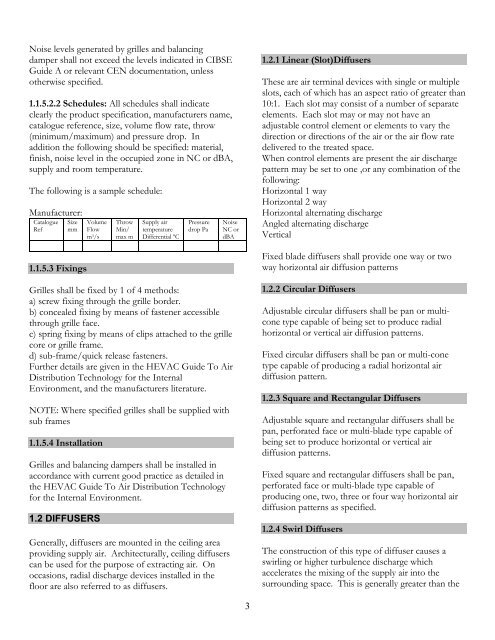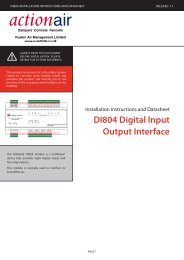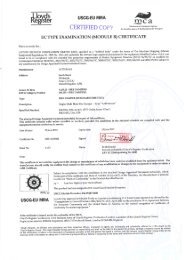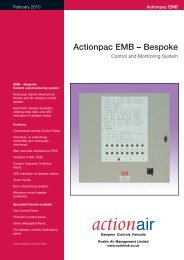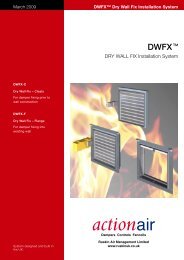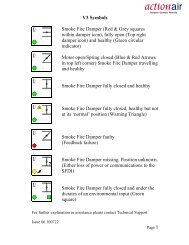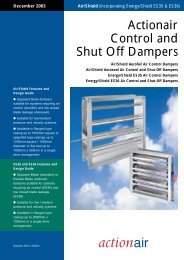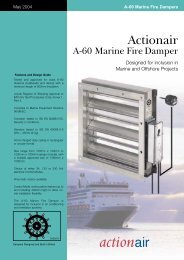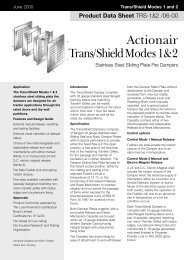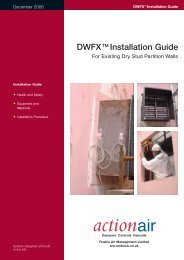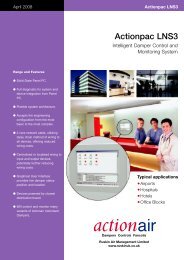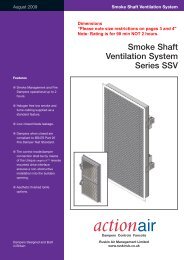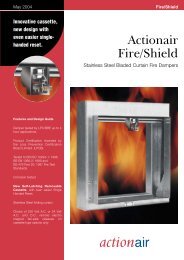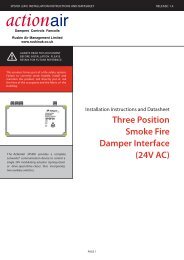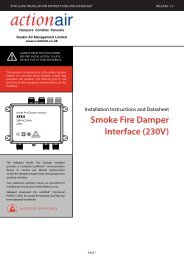SPECIFICATION FOR AIR DISTRIBUTION EQUIPMENT - Actionair
SPECIFICATION FOR AIR DISTRIBUTION EQUIPMENT - Actionair
SPECIFICATION FOR AIR DISTRIBUTION EQUIPMENT - Actionair
You also want an ePaper? Increase the reach of your titles
YUMPU automatically turns print PDFs into web optimized ePapers that Google loves.
Noise levels generated by grilles and balancing<br />
damper shall not exceed the levels indicated in CIBSE<br />
Guide A or relevant CEN documentation, unless<br />
otherwise specified.<br />
1.1.5.2.2 Schedules: All schedules shall indicate<br />
clearly the product specification, manufacturers name,<br />
catalogue reference, size, volume flow rate, throw<br />
(minimum/maximum) and pressure drop. In<br />
addition the following should be specified: material,<br />
finish, noise level in the occupied zone in NC or dBA,<br />
supply and room temperature.<br />
The following is a sample schedule:<br />
Manufacturer:<br />
Catalogue<br />
Ref<br />
Size<br />
mm<br />
1.1.5.3 Fixings<br />
Volume<br />
Flow<br />
m 3 /s<br />
Throw<br />
Min/<br />
max m<br />
Supply air<br />
temperature<br />
Differential ºC<br />
Pressure<br />
drop Pa<br />
Noise<br />
NC or<br />
dBA<br />
Grilles shall be fixed by 1 of 4 methods:<br />
a) screw fixing through the grille border.<br />
b) concealed fixing by means of fastener accessible<br />
through grille face.<br />
c) spring fixing by means of clips attached to the grille<br />
core or grille frame.<br />
d) sub-frame/quick release fasteners.<br />
Further details are given in the HEVAC Guide To Air<br />
Distribution Technology for the Internal<br />
Environment, and the manufacturers literature.<br />
NOTE: Where specified grilles shall be supplied with<br />
sub frames<br />
1.1.5.4 Installation<br />
Grilles and balancing dampers shall be installed in<br />
accordance with current good practice as detailed in<br />
the HEVAC Guide To Air Distribution Technology<br />
for the Internal Environment.<br />
1.2 DIFFUSERS<br />
Generally, diffusers are mounted in the ceiling area<br />
providing supply air. Architecturally, ceiling diffusers<br />
can be used for the purpose of extracting air. On<br />
occasions, radial discharge devices installed in the<br />
floor are also referred to as diffusers.<br />
1.2.1 Linear (Slot)Diffusers<br />
These are air terminal devices with single or multiple<br />
slots, each of which has an aspect ratio of greater than<br />
10:1. Each slot may consist of a number of separate<br />
elements. Each slot may or may not have an<br />
adjustable control element or elements to vary the<br />
direction or directions of the air or the air flow rate<br />
delivered to the treated space.<br />
When control elements are present the air discharge<br />
pattern may be set to one ,or any combination of the<br />
following:<br />
Horizontal 1 way<br />
Horizontal 2 way<br />
Horizontal alternating discharge<br />
Angled alternating discharge<br />
Vertical<br />
Fixed blade diffusers shall provide one way or two<br />
way horizontal air diffusion patterns<br />
1.2.2 Circular Diffusers<br />
Adjustable circular diffusers shall be pan or multicone<br />
type capable of being set to produce radial<br />
horizontal or vertical air diffusion patterns.<br />
Fixed circular diffusers shall be pan or multi-cone<br />
type capable of producing a radial horizontal air<br />
diffusion pattern.<br />
1.2.3 Square and Rectangular Diffusers<br />
Adjustable square and rectangular diffusers shall be<br />
pan, perforated face or multi-blade type capable of<br />
being set to produce horizontal or vertical air<br />
diffusion patterns.<br />
Fixed square and rectangular diffusers shall be pan,<br />
perforated face or multi-blade type capable of<br />
producing one, two, three or four way horizontal air<br />
diffusion patterns as specified.<br />
1.2.4 Swirl Diffusers<br />
The construction of this type of diffuser causes a<br />
swirling or higher turbulence discharge which<br />
accelerates the mixing of the supply air into the<br />
surrounding space. This is generally greater than the<br />
3


